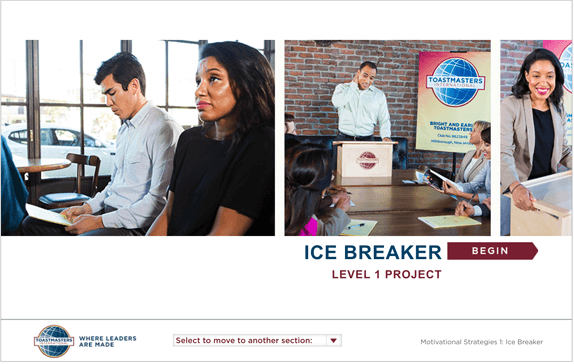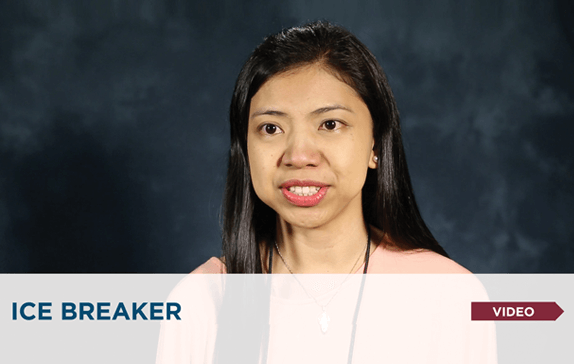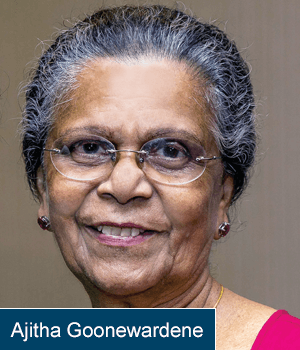The Possibilities of PATHWAYS
Toastmasters’ innovative new learning experience offers an expanded education.

In 2010, the Toastmasters Board of Directors crafted a five-year strategic plan that laid out the goals and objectives for the organization over the next five years. The plan’s centerpiece? A call to revitalize the Toastmasters education program.
Much of the communication track hadn’t been updated since the 1970s, and leadership became a separate track in 2005. The Board stressed the need to modernize the communication track and to renew the focus on leadership learning in the leadership track.
That original vision marked the beginning of a hugely ambitious effort to enhance the education program. Scheduled to roll out next year, the program will offer members more opportunities to learn and grow, highlighted by greater access to educational materials, expanded tools and resources, and a customized learning experience designed to help individuals meet personal and professional goals.
Currently, the project is referred to as the revitalized education program. The actual name of the new program will be Toastmasters Pathways learning experience, reflecting a journey of possibilities and progress.
“Our organization is all about helping people fulfill their potential, and Pathways embodies that concept,” says Toastmasters International President Jim Kokocki. “This is such a dynamic program for members: You’ll have the opportunity to develop more skills than ever before—skills that will help you succeed inside and outside of Toastmasters.”
Keeping the Key Concepts
Pathways is not a departure from the current education program. It maintains Toastmasters’ guiding principles and educational concepts. Club meetings will still be at the heart of the Toastmasters experience. The new program builds on the best of what we have now. It takes the education program to the next level, but at its foundation, Pathways is anchored in the vision of Toastmasters’ founder Ralph C. Smedley.

The educational content has been built and developed meticulously, grounded in the most current, effective principles of instructional design. In addition, the content has been thoroughly vetted by members, who have praised it as innovative, engaging and relevant to members’ needs today.
The positive response can be traced to the countless hours of hard work, and teamwork, that spurred the revitalization process. The end result isn’t just the handiwork of Toastmasters’ education development team at Toastmasters’ World Headquarters: Creating the new program has required a tremendous collaborative effort among the Board of Directors, the education team—and other departments—at World Headquarters, vendors and experts, and thousands of members.
Members were asked to play a vital role in the process. Early on, more than 270 members were chosen to be Learning Masters, a group that offered valuable feedback to the Pathways team on the educational content and learning experience. Other members were chosen as Chief Ambassadors and Ambassadors, to share information about the program with members, making them aware of the many benefits it offers, providing updates on its progress and answering questions.
The Board’s vision set the revitalization project in motion. Then, to build the foundation for an education program that would best serve members, the team immersed itself in research and analysis, studying data and reviewing feedback from current and former members about what they wanted to see in an education program. The team evaluated the Toastmasters learning experience in great depth.
What ultimately emerged is a more robust education program, one that enables members to develop an array of skills that are relevant in their personal and professional lives.
At the Board’s direction, Pathways was developed with these benefits for members:
- Recognition that comes earlier and more often in the educational journey
- New technological resources to improve speeches and support meeting roles
- Mobile access to educational materials (tablets)
- Expanded video and digital content to facilitate learning among our global community of members
- Stronger evaluation and mentoring components
“Pathways is going to be a world-class program that will help members succeed, and thrive, in an evolving global society,” says Kokocki.
The Structure
As Ralph Smedley realized, communication and leadership are inextricably linked.
In the new education program, they will
no longer be separate tracks—they will be
combined. From its review and analysis
of the current program paired with the
leadership experience, the Pathways team
identified the five core competencies
members can learn by participating in the
new program:
- Public Speaking
- Interpersonal Communication
- Leading and Managing
- Leading Strategically
- Building Confidence
These are the core competencies, but within those broader areas are many other competencies (and sub-competencies) as well. The Pathways team took foundational competencies in the Competent Communication and Competent Leader manuals (like learning basic speech structure, effective delivery and how to communicate well within a team) and built upon them. The current education program teaches 68 competencies; Pathways adds more than 250 competencies members can learn.




Some of the new competencies are: understanding short- and long-term goals, speaking about personal strengths and weaknesses, answering questions effectively, leading with resourcefulness and flexibility, and demonstrating the value of volunteering.
The five core competencies were paired to form five disciplines. The program will launch with 10 different learning paths, based on these disciplines:
- Public Speaking + Interpersonal Communication
- Interpersonal Communication + Strategic Leadership
- Interpersonal Communication + Management
- Public Speaking + Management
- Public Speaking + Strategic Leadership
"The current education program teaches 68 competencies; Pathways adds more than 250 competencies members can learn."
Paths include Motivational Strategies, Presentation Mastery, Leadership Development, Persuasive Influence and Effective Coaching. When a member starts in the Pathways program, he or she takes an online path assessment. The assessment helps identify the member’s current skill levels as well as areas where they want to improve. The assessment then indicates which learning path best fits their needs. If they don’t want to work in the recommended path, they are free to choose another path.
Each of the 10 paths includes a minimum of 14 learning projects, a mix of required and elective. Projects span a wide range, with many different topics to interest members and stretch their skills. Project topics include: how to motivate others, delivering social speeches, making connections through networking, how to lead in difficult times, understanding your communication style, using presentation software, learning to reach consensus, and many more.
Members advance through their paths in five levels of progressing complexity. The levels are defined this way:
- Mastering Fundamentals
- Learning Your Style
- Increasing Knowledge
- Building Skills
- Demonstrating Expertise
The idea is to build on what you learned in the previous level. The goal throughout the Pathways program is to not just learn, but to apply what you learn.
Online and Interactive
Because Pathways is offered online, many interactive learning
tools, including quizzes, assessments and activities, are featured
in the projects. Members can use the program online or use
both online and print materials. You can print materials directly
from the learning management system—the system from which
members access the online materials. In Pathways, this system is
called Base Camp. Think of the program as a journey of personal
development, an educational ascent. Reach for the top!
Members who choose to have the materials shipped to them from World Headquarters will not have access to the interactive learning tools or to as many learning paths as those who participate online.
Education videos are a key component of the new program. In addition, all educational materials in Pathways, including the videos, will be translated into eight languages.
BUILDING PATHWAYS
The story of the Toastmasters Pathways education program officially began in 2010, when the Board of Directors called for the current program to be revitalized. Since then, many more chapters have been added to the story.
Understanding the history of the program’s development helps put the project into perspective. Early in the process a Board committee analyzed the skills, competencies and attributes required to succeed in all different roles in Toastmasters, including club-meeting roles and leadership roles at all levels.
The committee studied where members learned these skills, competencies and attributes—was it in Toastmasters or outside Toastmasters? This detailed analysis was a critical step in the revitalization process: It determined the gaps in the Toastmasters learning experience.
The Pathways development team also gathered data through a competitive analysis and member surveys. They learned what members wanted to see in an education program:
- Real-world skills they could apply to their personal and professional lives
- A better use of technology in the educational journey
- Online access to educational projects
- A flexible learning experience to help them meet their individual goals
The content that has resulted from this early and extensive work reflects a dynamic, skill-loaded program that will benefit members in many ways.
The story continues.
The Content Pilot
Last year, the Pathways team conducted a pilot to test the educational
content of the program. It marked the first time any of the
learning projects were completed in the club setting. More than
800 members participated in the content pilot—members from
168 clubs across 79 districts in 23 countries. Every learning project
was reviewed at least six times.
The members provided feedback through project surveys. The Pathways team received more than 1,200 surveys, and the response was resoundingly positive.
Members also provided suggestions and constructive comments. The Pathways team carefully reviewed all pilot feedback and made important adjustments to projects based on the input.
Jing Humphreys, a Learning Master who participated in the pilot, says the program is user-friendly and easy to follow, adding that she was struck by “how current the content is and how relevant it is to something you would experience in your professional life.”
What’s Next?
The Pathways learning management system is going to be thoroughly
tested before the program is released to members. The
user experience will be simulated, any system bugs will be identified
and corrected, and the quality will be ensured.
In January 2017, the program pilot will be conducted, in which three districts will try out Pathways. After that, Pathways will launch in a phased rollout by region—and members around the world will embark on an adventure in learning.
Says Humphreys: “It’s exciting all the way around.”
Content Pilot
The recent content pilot marked an opportunity for members around the world to test the educational content in the new program. More than 800 members in 23 countries completed a range of learning projects in the club setting.
Learning Masters and Chief Ambassadors, member volunteers in the revitalization process, served as liaisons in the content pilot, leading participating clubs in the process. Learning Master Ajitha Goonewardene, DTM, a member in Colombo, Sri Lanka, says the learning projects she completed “were just excellent. They covered a variety of subjects that suited many people with different interests.”
Chief Ambassador Rob Christeson, DTM, says the projects contained valuable and relevant information. One, for example, teaches learning skills to be successful at project management—something Christeson was particularly curious about, because he works as an Information Technology project manager.
“Even for someone like me, who has a lot of experience in that area, I thought there was a lot of good information,” says Christeson, a member of three clubs in Kansas. “Some of the additional handouts and tools are things you can really use on the job.”
Learning Master Jing Humphreys, DTM, a member of two clubs in Pennsylvania, led five clubs in the content pilot. The feedback from members, she says, was very positive. “They felt the content was customized to members’ needs.”
The evaluation component of the revitalized program also drew praise. Evaluation guidelines are more rigorous and expansive than in the current program.
In the new program, evaluators are also encouraged to address the content in the speeches they are evaluating, something that Christeson says is useful.
A number of learning projects teach current methods of communication that are increasingly popular and that might be new to many members, such as communicating through blogs and podcasts. Goonewardene says she is embracing such challenges.
“For me, using the new methods involving technology was a great learning experience,” she says. “I am 77 years of age and have been a Toastmaster for 16 years and these projects opened a new line of advanced learning and interest for me.


5 Questions about Pathways
Q Why are we revitalizing the current education program?
A Toastmasters’ Board of Directors called on the organization to modernize the communication track and renew the focus on leadership learning. Additionally, there is a growing need to provide greater access to educational materials, expanded learning resources and an educational experience in which you learn skills you can transfer out into the world.
Q What will happen to the DTM in the new program?
A The DTM will still represent the highest level of educational achievement in Toastmasters. The specific requirements for achieving a DTM, as well as details surrounding recognition in Pathways, are still being finalized.
Q If I am currently working toward an education award, will I be able to finish by the time Pathways launches?
A Yes. The current and new programs will run concurrently for a minimum of 24 months after all districts have been included in the program rollout.
Q When will the new program start?
A The Toastmasters Pathways learning experience is scheduled to launch next year, in a phased rollout by region.
Q Will we have help learning to use the new program online?
A Yes! All Toastmasters leaders, from club leaders on up, will be trained in using the program online so they can help members use it.
PAUL STERMAN is senior editor of Toastmaster magazine.
Visit www.toastmasters.org/Resources/Pathways to learn more about The Toastmasters Pathways Learning Experience.
